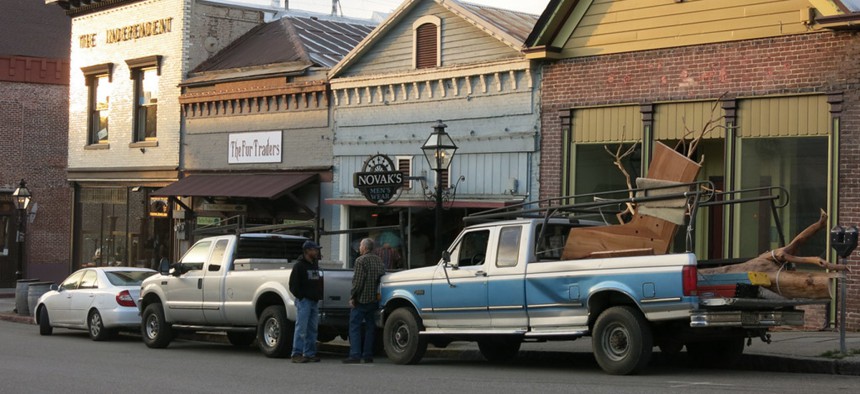How a Tiny Mountain Town Quadrupled Parking Fees

Nevada City, California, used to advertise its “bargain” parking meters. Nevada City Chamber
Nevada City, California, used to advertise its “bargain” parking meters. Now they’re getting more expensive to protect the town against an existential threat.
A lot about Nevada City, California, could be described as quaint. The main drag, Broad Street, is a sloping corridor of Gold Rush-era shops and inns. During the holidays, horse-drawn carriages and gas lamps transform it into a Victorian Christmas fantasy. Last year, to fight wildfire risk, the vice mayor launched a fundraiser for a livestock brush control program, calling it “GoatFundMe.”
But now this popular weekend retreat in the foothills of the northern Sierra Nevadas, population 3,000, has shed one of its defining throwback features. Last month, the city council voted to raise the hourly rates of parking meters from 25 cents to a full dollar.
It was the first cost increase in decades, if ever, said Erin Minett, a recently elected city council member who pushed for the increase. “People used to come to the city and laugh—‘Oh, it’s only 25 cents, how cute!’” she said. (Even the city’s website advertises the remarkably cheap meters: “What a bargain! Bring change with you when you visit us!”)
There were many reasons to kick up the fees, which will go into effect sometime this year. The 237 parking meters around town brought in less than $10,000 a month. That wasn’t enough to cover the salaries of the public works employees managing them, said Dwayne Strawser, another city council member and a local bike shop owner. “I can’t in good faith have a parking program where folks who don’t pay to park are still covering parking through their taxes,” Strawser said.
And because it was so painless to keep feeding the meters, employees of businesses along Broad Street were known to leave their cars out front for their entire shifts, crowding out other visitors, including all-important tourists. In addition to the rate increase, the town is expanding an employee parking lot a few blocks away from Broad Street. (In total, Nevada City is two square miles.)
And lastly, the town will be putting the extra funds to good use: fighting flames. Surrounded by dense forests, Nevada City is one of 188 communities in California listed for extreme wildfire danger, and residents fear they’ll face the same fate as Paradise, the mountain enclave destroyed in last year’s fire season. Of the estimated $550,000 a year that the new parking rates will generate, 20 percent will pay to clear flammable undergrowth, Minett said, and for an emergency siren at city hall to help people evacuate.
The fourfold parking fee increase has received pushback, of course. “Goodbye to ice cream, candy, and many incidental merchants who cannot survive only on weekend tourist traffic,” one incensed resident commented on a local news article. Some business owners feel that they weren’t adequately consulted in the several months that the council was considering the increase. “It happened so fast,” said Cathy Whittlesey, the executive director of the Nevada City Chamber of Commerce.
But Minett hopes that attaching a concrete social objective to the rate hikes is enough to stave off too much controversy. Nevada City has been applying for state grants to suppress wildfire risk, but it’s too small to qualify for many of them. “What are we supposed to do?” she said. “We’ve already burned down twice in our history. We’ve got to take care of the problem.” The town can always reverse course if the higher rates don’t work out, she added.
But many cities have seen success with raising meter rates and directing the revenue to sorely needed public services. A few hundred miles away in Southern California, Old Town Pasadena is the poster child of a downtown corridor that used pricier parking fees to beautify the streets and improve infrastructure. “Urban planners tend to focus on policy goals; people care to see the results,” Donald Shoup, the UCLA urban economist and renowned parking policy expert, told CityLab last year. Nevada City seems to be putting that philosophy into action.
And its rates are still highly affordable compared to nearby cities—Truckee charges as much as $1.50, and Sacramento charges between $1.75 and $3.75.
Strawser had long advocated for making parking entirely free in Nevada City, since that’s how Grass Valley, a larger neighboring town, had long operated. But then Grass Valley put in a parking program at a dollar per hour in 2018, which took some wind of Strawser’s sails. “At that point, I lost my next-door neighbor example,” he said. So when Nevada City’s city council voted to raise rates, Strawser had a considerable change of heart. He was the one who actually pushed for the dollar amount—double the 50 cents that the city’s department of public works initially asked for, and still more than the 75 cents that Minett had thought wise.
Other leaders were pleased. “I’ve always thought we do not charge enough,” another council member, Valerie Moberg, told a local newspaper. And Minett sees the meter hikes as a win-win for the city and citizens, in that they’ll help save lives in case of fire and free up space downtown. “I want Nevada City to stay sweet, but also keep up with the times,” she said. “I thought this was a two-fer.”
Laura Bliss is the west coast bureau chief for CityLab.
NEXT STORY: When Millions Can’t Afford to Retire, the U.S. Needs a Better Option





